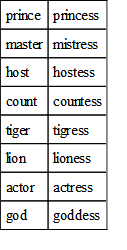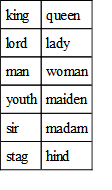GENDER
85. All of the changes we have studied so far have been for the purpose of indicating number; but among the nouns that name living beings, many change to show to which sex the object named belongs. These nouns change in form to distinguish between the masculine and the feminine. This is called gender.
Gender is the distinction in words that denotes sex.
The nouns that denote females are called feminine nouns.
The nouns that denote males are called masculine nouns.
86. The feminine form is generally made by the addition of ess to the masculine form. Thus:

87. Names of things without sex are, of course, of neither gender, and are called neuter nouns. Neuter means literally neither. Such nouns as mountain, iron, river, chair, are neuter.
Sometimes the feminine is an entirely different word from the masculine. Thus:

88. Many nouns that denote living beings apply alike to male and female, and are said to be of common gender. As woman enters more and more into the business world and pursues the same occupations as man, the change in form to denote the feminine is used less frequently, and what we have called the masculine form is used for both sexes, thus:
Poet, waiter, doctor, editor—these nouns are used for both men and women.
Более 800 000 книг и аудиокниг! 📚
Получи 2 месяца Литрес Подписки в подарок и наслаждайся неограниченным чтением
ПОЛУЧИТЬ ПОДАРОКДанный текст является ознакомительным фрагментом.